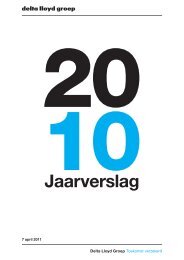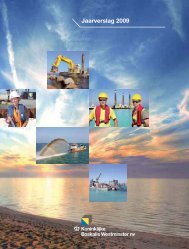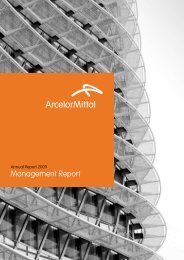2008 Annual Report - SBM Offshore
2008 Annual Report - SBM Offshore
2008 Annual Report - SBM Offshore
- No tags were found...
You also want an ePaper? Increase the reach of your titles
YUMPU automatically turns print PDFs into web optimized ePapers that Google loves.
<strong>SBM</strong> <strong>Offshore</strong> <strong>Annual</strong> <strong>Report</strong> <strong>2008</strong> / Financial Statements <strong>2008</strong> 97Joint venturesJoint ventures are those entities over whose activities the Company has joint control, established by contractual agreement. Thefinancial statements include the Company’s proportionate share of the joint venture entities’ assets, liabilities, revenue and expenses,with items of a similar nature on a line by line basis, from the date that joint control commences until the date that joint control ceases.The Company recognises the portion of gains and losses on the sale of assets by the Company to the joint venture that is attributableto the other venturers.Transactions eliminated on consolidationIntragroup balances, and any unrealised gains and losses or income and expenses arising from intragroup transactions (which aremade at arms length), are eliminated in preparing the consolidated financial statements. Accounting policies of subsidiaries have beenchanged where necessary to ensure consistency with the policies adopted by the Company. Unrealised gains arising from transactionswith associates and jointly controlled entities are eliminated to the extent of the Company’s interest in the entity. Unrealised losses areeliminated in the same way as unrealised gains, but only to the extent that there is no evidence of impairment.Segment reportingA segment is a group of assets and operations engaged in providing products and services that are subject to risks and returns thatare different from those of other segments. A geographical segment relates to the provision of products or services within a particulareconomic environment that is subject to risks and returns that are different from other economic environments. The classification bygeographical area is determined by the final destination of the product.Foreign currency translationFunctional and reporting currencyItems included in the financial statements of each of the Company’s entities are measured using the currency of the primary economicenvironment in which the entity operates (the ‘functional currency’). The functional currency of the offshore oil and gas activities is theUS Dollar. The consolidated financial statements are presented in US Dollars, which is the reporting currency of the Company.Transactions and balancesForeign currency transactions are translated into the functional currency using the exchange rates prevailing at the dates of thetransactions. Foreign exchange gains and losses resulting from the settlement of foreign currency transactions and from the translationat period end exchange rate of monetary assets and liabilities denominated in foreign currencies are recognised in the incomestatement, except where hedge accounting is applied.At year-end <strong>2008</strong> the most important rate was the Euro at US$ 1.398 (opening <strong>2008</strong>: US$ 1.472). The average Euro rate amounted toUS$ 1.469 (2007: US$ 1.368).Group companiesThe result and financial position of all Group companies that have a functional currency different from the reporting currency aretranslated into the reporting currency as follows:• assets and liabilities for each balance sheet presented are translated at the closing rate at the date of the balance sheet;• income and expenses are translated at the average exchange rate (unless this average rate is not a reasonable approximation of thecumulative effect of the rates prevailing on the transaction dates, in which case income and expenses are translated at the date ofthe transactions); and• all resulting exchange differences are recognised as a separate component of equity (Translation reserve).Exchange differences arising from the translation of the net investment in foreign entities, and of borrowings of such investments, aretaken to Group equity on consolidation. When an operation denominated in foreign currency is sold, such exchange differences arerecognised in the income statement as part of the gain or loss on sale.Goodwill and fair value adjustments arising on the acquisition of a foreign entity are treated as assets and liabilities of the foreign entityand translated at the closing rate.
















